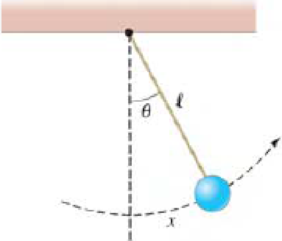
Concept explainers
In Section 14–5, the oscillation of a simple pendulum (Fig. 14–46) is viewed as linear motion along the are length x and analyzed via F = ma. Alternatively, the pendulum’s movement can be regarded as rotational motion about its point of support and analyzed using τ = Iα. Carry out this alternative analysis and show that
where θ(t) is the
FIGURE 14–46
Problem 92.

Want to see the full answer?
Check out a sample textbook solution
Chapter 14 Solutions
EBK PHYSICS FOR SCIENTISTS & ENGINEERS
Additional Science Textbook Solutions
Chemistry: The Central Science (14th Edition)
Chemistry: Structure and Properties (2nd Edition)
Human Physiology: An Integrated Approach (8th Edition)
Chemistry: An Introduction to General, Organic, and Biological Chemistry (13th Edition)
Human Anatomy & Physiology (2nd Edition)
Campbell Biology (11th Edition)
- If the speed of the observer is increased by 5.0%, what is the period of the pendulum when measured by this observer?arrow_forwardFind the frequency of a tuning fork that takes 2.50103 s to complete one oscillation.arrow_forwardThe angular position of a pendulum is represented by the equation = 0.032 0 cos t, where is in radians and = 4.43 rad/s. Determine the period and length of the pendulum.arrow_forward
- Give an example of a simple harmonic oscillator, specifically noting how its frequency is independent of amplitude.arrow_forwardShow that the time rate of change of mechanical energy for a damped, undriven oscillator is given by dE/dt = bv2 and hence is always negative. To do so, differentiate the expression for the mechanical energy of an oscillator, E=12mv2+12kx2, and use Equation 12.28.arrow_forwardRefer to the problem of the two coupled oscillators discussed in Section 12.2. Show that the total energy of the system is constant. (Calculate the kinetic energy of each of the particles and the potential energy stored in each of the three springs, and sum the results.) Notice that the kinetic and potential energy terms that have 12 as a coefficient depend on C1 and 2 but not on C2 or 2. Why is such a result to be expected?arrow_forward
- Check Your Understanding Identify one way you could decrease the maximum velocity of a simple harmonic oscillator.arrow_forwardAn automobile with a mass of 1000 kg, including passengers, settles 1.0 cm closer to the road for every additional 100 kg of passengers. It is driven with a constant horizontal component of speed 20 km/h over a washboard road with sinusoidal bumps. The amplitude and wavelength of the sine curve are 5.0 cm and 20 cm, respectively. The distance between the front and back wheels is 2.4 m. Find the amplitude of oscillation of the automobile, assuming it moves vertically as an undamped driven harmonic oscillator. Neglect the mass of the wheels and springs and assume that the wheels are always in contact with the road.arrow_forwardCheck Your Understanding Why are completely undamped harmonic oscillators so rare?arrow_forward
- Calculate the maximum values of the amplitudes of the response functions shown in Figures 3-22 and 3-24. Obtain numerical values for β = 0.2ω0 when a = 2 m/s2, ω0 = 1 rad/s, and t0 = 0.arrow_forwardMost harmonic oscillators are damped and, if undriven, eventually come to a stop. Why?arrow_forwardSome people think a pendulum with a period of 1.00 s can be driven with “mental energy” or psycho kinetically, because its period is the same as an average heartbeat. True or not, what is the length of such a pendulum?arrow_forward
 Classical Dynamics of Particles and SystemsPhysicsISBN:9780534408961Author:Stephen T. Thornton, Jerry B. MarionPublisher:Cengage Learning
Classical Dynamics of Particles and SystemsPhysicsISBN:9780534408961Author:Stephen T. Thornton, Jerry B. MarionPublisher:Cengage Learning Principles of Physics: A Calculus-Based TextPhysicsISBN:9781133104261Author:Raymond A. Serway, John W. JewettPublisher:Cengage Learning
Principles of Physics: A Calculus-Based TextPhysicsISBN:9781133104261Author:Raymond A. Serway, John W. JewettPublisher:Cengage Learning Physics for Scientists and Engineers: Foundations...PhysicsISBN:9781133939146Author:Katz, Debora M.Publisher:Cengage Learning
Physics for Scientists and Engineers: Foundations...PhysicsISBN:9781133939146Author:Katz, Debora M.Publisher:Cengage Learning University Physics Volume 1PhysicsISBN:9781938168277Author:William Moebs, Samuel J. Ling, Jeff SannyPublisher:OpenStax - Rice University
University Physics Volume 1PhysicsISBN:9781938168277Author:William Moebs, Samuel J. Ling, Jeff SannyPublisher:OpenStax - Rice University Physics for Scientists and EngineersPhysicsISBN:9781337553278Author:Raymond A. Serway, John W. JewettPublisher:Cengage Learning
Physics for Scientists and EngineersPhysicsISBN:9781337553278Author:Raymond A. Serway, John W. JewettPublisher:Cengage Learning Physics for Scientists and Engineers with Modern ...PhysicsISBN:9781337553292Author:Raymond A. Serway, John W. JewettPublisher:Cengage Learning
Physics for Scientists and Engineers with Modern ...PhysicsISBN:9781337553292Author:Raymond A. Serway, John W. JewettPublisher:Cengage Learning





